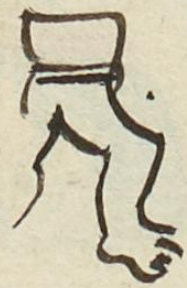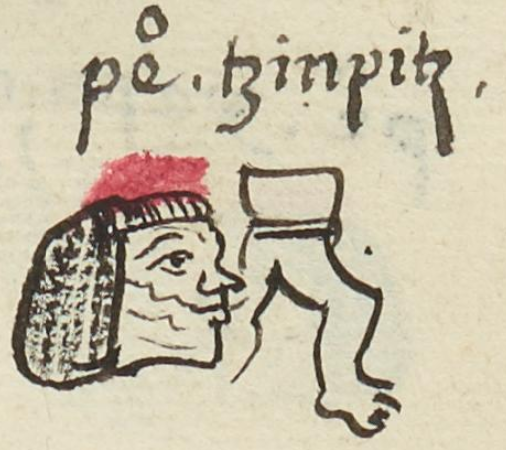Tzinpitz (MH677v)
This black-line drawing of the compound glyph for the personal name Tzimpitz (“Tapered at the Bottom”) is attested here as a man’s name. The glyph shows the lower half of a man’s body, in profile, facing toward the viewer’s right. He wears a loincloth. A wavy line comes downward from his bottom (tzintli), perhaps a suggestion of diarrhea, which would point to the word apitza (to have diarrhea). Whether this is meant literally or serving as a phonetic indicator for the -pitz part of the name is unclear. If this compound has nothing to do with bottoms or diarrhea, then perhaps it is a compound that is fully phonetic to refer to a shape that is tapered toward the bottom (tzimpitzahua). Perhaps this name should be spelled Tzimpitz.
Stephanie Wood
1560
Jeff Haskett-Wood
tzimpitz, cosa figurada, nombres de hombres

tzimpitzahua, something shaped, tapered toward the bottom, https://nahuatl.wired-humanities.org/content/tzimpitzahuac
tzin(tli), rear end, bottom, https://nahuatl.wired-humanities.org/content/tzintli
apitza, to have diarrhea, https://nahuatl.wired-humanities.org/content/apitza
Cosa Ahusada Hacia Abajo
Stephanie Wood
Matrícula de Huexotzinco, folio 677v, World Digital Library, https://www.loc.gov/resource/gdcwdl.wdl_15282/?sp=435&st=image.
This manuscript is hosted by the Library of Congress and the World Digital Library; used here with the Creative Commons, “Attribution-NonCommercial-ShareAlike 3.0 License” (CC-BY-NC-SAq 3.0).





